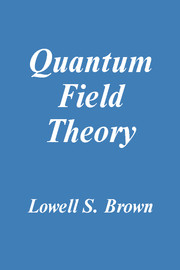6 - Structural aspects
Published online by Cambridge University Press: 05 August 2012
Summary
We turn now to describe some important general features of quantum field theory so that one can obtain a better overall view of the theory. This will be done by continuing to use the scalar theory as an illustration. We shall first investigate the structure of the interacting propagator — the two-point Green's function. This structure will tell us how to construct single-particle states for an interacting theory. The single-particle state construction will then be extended to multiparticle states, and the relationship of n-point Green's functions to scattering amplitudes will be obtained. This relationship is called the “reduction formula”. The interacting propagator can also describe unstable particles, and this will be explained including an outline of how such particles are produced and detected and how very short-lived particles appear as resonances in scattering amplitudes. The effective action will then be introduced, and it will be shown to be the generating functional of connected amplitudes. As a by-product, the cluster decomposition theorem will be described and the fact that the power of Planck's constant ħ counts the number of closed loops in a graph will be explained. Finally, the Legendre transform of the effective action will be examined. It is the generating function of single-particle irreducible, connected graphs. Its restriction to constant fields defines the effective potential which is a useful instrument for describing spontaneously broken symmetry.
- Type
- Chapter
- Information
- Quantum Field Theory , pp. 282 - 353Publisher: Cambridge University PressPrint publication year: 1992



